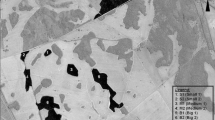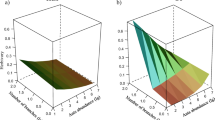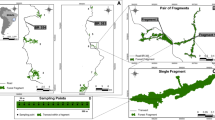Abstract
Edge effects are among the most important drivers of species interactions in fragmented habitats, but the impacts of edge effects on multitrophic interactions are largely unknown. In this study we assess edge effects on species interactions within an ant–plant mutualistic system—where ants protect plants against herbivory—to determine whether habitat edges alter the amount of protection ants provide. We focus on a single species of myrmecophytic plant, Solanum americanum, and experimentally manipulate ant access to study plants in large-scale fragmented habitat patches at the Savannah River Site National Environmental Research Park, USA. In this system, S. americanum commonly hosts honeydew-producing aphids that are tended by ants, and grasshoppers are the primary herbivores. We measured edge effects on the per-plant abundance of aphids and protective ants as well as the abundance of grasshoppers in each habitat patch, and we evaluated levels of ant protection against herbivory near and far from habitat edges. We found that ants provided significant protection to plants far from edges, where herbivory pressure was highest, despite the fact that aphids and ants were least abundant on these plants. Conversely, ants did not provide significant protection near edges, where herbivory pressure was lowest and aphids and ants were most abundant. We conclude that a strong edge effect on grasshopper abundance was a key factor determining the amount of protection ants provided against herbivory. Future studies of the impacts of habitat fragmentation on ant–plant mutualisms will benefit from studies of ant behavior in response to herbivory threats, and studies of edge effects on other species interactions may also need to consider how species’ behavioral patterns influence the interactions in question.


Similar content being viewed by others
References
Agrawal AA (2011) Current trends in the evolutionary ecology of plant defence. Funct Ecol 25:420–432
Agrawal AA, Rutter MT (1998) Dynamic anti-herbivore defense in ant-plants: the role of induced responses. Oikos 83:227–236
Bach CE, Kelly D (2004) Effects of forest edges on herbivory in a New Zealand mistletoe, Alepis flavida. N Z J Ecol 28:195–205
Bates D, Sarkar D (2010) lme4: Linear Mixed-Effects Models Using S4 Classes. R package version 0.999375-33. http://cran.r-project.org/web/packages/lme4/index.html. Accessed 17 July 2013
Beattie AJ (1985) The evolutionary ecology of ant–plant mutualisms. Cambridge University Press, Cambridge
Beattie AJ, Hughes L (2002) Ant–plant interactions. In: Herrera CM, Pellmyr O (eds) Plant–animal interactions: an evolutionary approach. Blackwell Science, Oxford, pp 211–235
Braschler B, Lampel G, Baur B (2003) Experimental small-scale grassland fragmentation alters aphid population dynamics. Oikos 100:581–591
Bretz F, Hothorn T, Westfall P (2010) Multiple Comparisons Using R. CRC Press, New York
Bronstein JL (1994) Conditional outcomes in mutualistic interactions. Trends Ecol Evol 9:214–217
Bruna EM, Lapola DM, Vasconcelos HL (2004) Interspecific variation in the defensive responses of obligate plant–ants: experimental tests and consequences for herbivory. Oecologia 138:558–565
Bruna EM, Vasconcelos HL, Heredia S (2005) The effect of habitat fragmentation on communities of mutualists: amazonian ants and their host plants. Biol Conserv 124:209–216
Carroll CR, Janzen DH (1973) Ecology of foraging ants. Annu Rev Ecol Evol Syst 4:231–257
Carvalho KS, Vasconcelos HL (1999) Forest fragmentation in central amazonia and its effects on litter-dwelling ants. Biol Conserv 91:151–157
Casida JE, Quistad GB (eds) (1995) Pyrethrum flowers: production, chemistry, toxicology, and uses. Oxford University Press, Oxford
Collinge SK (2009) Ecology of fragmented landscapes. Johns Hopkins University Press, Baltimore
Crawley MJ (2007) The R book. Wiley and Sons, Chichester
Cushman JH, Addicott JF (1991) Conditional interactions in ant–plant-herbivore mutualisms. In: Huxley CR, Cutler DF (eds) Ant–plant interactions. Oxford University Press, Oxford, pp 92–103
Debuse VJ, King J, House APN (2007) Effect of fragmentation, habitat loss and within-patch habitat characteristics on ant assemblages in semi-arid woodlands of eastern Australia. Landscape Ecol 22:731–745
Evans DM, Turley NE, Levey DJ, Tewksbury JJ (2012) Habitat patch shape, not corridors, determines herbivory and fruit production of an annual plant. Ecology 93:1016–1025
Fagan WE, Cantrell RS, Cosner C (1999) How habitat edges change species interactions. American Naturalist 153:165–182
Fiala B, Maschwitz U (1990) Studies on the South East-Asian ant–plant association crematogaster: Borneensis macaranga—adaptations of the ant partner. Insectes Soc 37:212–231
Frechette B, Bejan M, Lucas E, Giordanengo P, Vincent C (2010) Resistance of wild Solanum accessions to aphids and other potato pests in Quebec field conditions. J Insect Sci 10:16
Futuyma DJ, Agrawal AA (2009) Macroevolution and the biological diversity of plants and herbivores. Proc Natl Acad Sci USA 106:18054–18061
Gibb H, Johansson T (2010) Forest succession and harvesting of hemipteran honeydew by boreal ants. Ann Zool Fenn 47:99–110
Hölldobler B, Wilson EO (1990) The ants. Belknap Press of Harvard University Press, Cambridge
Horvitz CC, Schemske DW (1984) Effects of ants and an ant-tended herbivore on seed production of a Neotropical herb. Ecology 65:1369–1378
Hothorn TF, Bretz P, Westfall RM, Heiberger, Schutzenmeister A (2010) multcomp: Simultaneous Inference for General Linear Hypotheses. R package version 1.1-7. http://cran.r-project.org/web/packages/multcomp/index.html. Accessed 17 July 2013
Hubner G (2000) Differential interactions between an aphid endohyperparasitoid and three honeydew-collecting ant species: a field study of Alloxysta brevis (Thomson) (Hymenoptera:Alloxystidae). J Insect Behav 13:771–784
Janzen DH (1966) Coevolution of mutualism between ants and acacias in Central America. Evolution 20:249–275
Janzen DH (1967) Interaction of the bull’s-horn acacia (Acacia cornigera L.) with an ant inhabitant (Pseudomyrmex ferruginea F. Smith) in eastern Mexico. Univ Kans Sci Bull 47:315–558
Janzen DH (1969) Allelopathy by myrmecophytes: ant azteca as an allelopathic agent of Cecropia. Ecology 50:147–153
Johnson JB, Omland KS (2004) Model selection in ecology and evolution. Trends Ecol Evol 19:101–108
Kaplan I, Eubanks MD (2005) Aphids alter the community-wide impact of fire ants. Ecology 86:1640–1649
Lapola DM, Bruna EM, Vasconcelos HL (2003) Contrasting responses to induction cues by ants inhabiting Maieta guianensis (Melastomataceae). Biotropica 35:295–300
Laurance WF, Camargo JLC, Luizao RCC, Laurance SG, Pimm SL, Bruna EM, Stouffer PC, Williamson GB, Benitez-Malvido J, Vasconcelos HL, Van Houtan KS, Zartman CE, Boyle SA, Didham RK, Andrade A, Lovejoy TE (2011) The fate of Amazonian forest fragments: a 32-year investigation. Biol Conserv 144:56–67
Lopez-Barrera F, Manson RH, Gonzalez-Espinosa M, Newton AC (2006) Effects of the type of montane forest edge on oak seedling establishment along forest-edge-exterior gradients. For Ecol Manag 225:234–244
Martinson H (2009) Interactions lost and gained: a review of how trophic interactions are impacted by the fragmentation of habitats. Doctoral Dissertation, University of Maryland, College Park
Massad TJ, Fincher RM, Smilanich AM, Dyer L (2011) A quantitative evaluation of major plant defense hypotheses, nature versus nurture, and chemistry versus ants. Arthropod Plant Interact 5:125–139
Meiners SJ, Handel SN, Pickett STA (2000) Tree seedling establishment under insect herbivory: edge effects and interannual variation. Plant Ecol 151:161–170
Messina FJ (1981) Plant protection as a consequence of an ant-membracid mutualism: interactions on goldenrod (Solidago sp.). Ecology 62:1433–1440
Ness JH, Bronstein IL (2004) The effects of invasive ants on prospective ant mutualists. Biol Invasions 6:445–461
Oliveira PS, Del-Claro K (2005) Multitrophic interactions in a Neotropical savannah: ant-hemipteran systems, associated insect herbivores, and a host plant. In: Burslem DFRP, Pinard MA, Hartley SE (eds) Biotic interactions in the tropics. Cambridge University Press, Cambridge
Oliveira PS, Freitas AVL (2004) Ant-plant-herbivore interactions in the neotropical cerrado savanna. Naturwissenschaften 91:557–570
Orrock JL, Curler GR, Danielson BJ, Coyle DR (2011) Large-scale experimental landscapes reveal distinctive effects of patch geometry and connectivity on arthropod communities. Landscape Ecol 26:1361–1372
Pompon J, Li XQ, Pelletier Y (2011) Resistance level to an aphid potato pest varies between genotypes from the same solanum accession. J Econ Entomol 104:1075–1079
R Development Core Team (2010) R: a language and environment for statistical computing. R Foundation for Statistical Computing, Vienna
Rico-Gray V, Oliveira PS (2007) The ecology and evolution of ant–plant interactions. University of Chicago Press, Chicago
Ries L, Fletcher RJ, Battin J, Sisk TD (2004) Ecological responses to habitat edges: mechanisms, models, and variability explained. Annu Rev Ecol Evol Syst 35:491–522
Schupp EW, Feener DH (1991) Ant-defended plants in a Panamanian forest. In: Huxley CR, Cutler DF (eds) Ant–plant interactions. Oxford University Press, Oxford
Semtner PJ, Tilson WM, Dara SK (1998) Performance of the tobacco aphid (Homoptera:Aphididae) on various host plants. J Entomol Sci 33:180–195
Shibao H, Morimoto M, Okumura Y, Shimada M (2009) Fitness costs and benefits of ant attendance and soldier production for the social aphid Pseudoregma bambucicola (Homoptera:Aphididae:Hormaphidinae). Sociobiology 54:673–698
Stadler B, Dixon AFG (2005) Ecology and evolution of aphid–ant interactions. Annual Review Of Ecology Evolution And Systematics, pp 345–372
Stechmann DH, Volkl W, Stary P (1996) Ant-attendance as a critical factor in the biological control of the banana aphid Pentalonia nigronervosa Coq (Homptera:Aphididae) in Oceania. J Appl Entomol Zeitschrift Fur Angewandte Entomologie 120:119–123
Styrsky JD, Eubanks MD (2010) A facultative mutualism between aphids and an invasive ant increases plant reproduction. Ecol Entomol 35:190–199
Tscharntke T, Brandl R (2004) Plant–insect interactions in fragmented landscapes. Annu Rev Entomol 49:405–430
Tscharntke T, Steffan-Dewenter I, Kruess A, Thies C (2002) Characteristics of insect populations on habitat fragments: a mini review. Ecol Res 17:229–239
Valladares G, Salvo A, Cagnolo L (2006) Habitat fragmentation effects on trophic processes of insect–plant food webs. Conserv Biol 20:212–217
Vasconcelos HL (1991) Mutualism between Maieta guianensis Aubl, a myrmecophytic melastome, and one of its ant inhabitants: ant protection against insect herbivores. Oecologia 87:295–298
Warriner RA, Gold RE, Austin JW (2008) Ecology of Dorymyrmex flavus (Hymenoptera:Formicidae) in Central Texas, including aspects of competition with Solenopsis invicta Buren. Sociobiology 52:229–250
Way MJ (1963) Mutualism between ants and honeydew-producing homoptera. Ann Rev Entomol 8:307–344
Westfall PH (1997) Multiple testing of general contrasts using logical constraints and correlations. J Am Stat Assoc 92:299–306
Westfall PH, Troendle JF (2008) Multiple testing with minimal assumptions. Biometrical J 50:745–755
Wimp GM, Murphy SM, Lewis D, Ries L (2011) Do edge responses cascade up or down a multi-trophic food web? Ecol Lett 14:863–870
Acknowledgments
We thank the USDA Forest Service-Savannah River for creating and maintaining our experimental landscapes; N. Haddad, D. Levey and L. Brudvig for their roles in designing and implementing the landscape experiment; E. Damschen, N. Haddad, D. Levey, and J. Orrock for their roles in maintaining the landscape experiment; the Corridor Project team for fruitful discussions that led to many ideas in this paper; L. Fenner, R. Malinen, and E. Smith for field assistance; J. Hille Ris Lambers and J. Lawler for reviewing the manuscript; and two anonymous reviewers for suggestions that also improved the manuscript. This research was supported by the National Science Foundation (DEB-0613701), by the University of Washington, and by funds provided to the Department of Agriculture, Forest Service, Savannah River, under Interagency Agreement DE-AI09-00SR22188 with the Department of Energy, Aiken, SC.
Author information
Authors and Affiliations
Corresponding author
Rights and permissions
About this article
Cite this article
Evans, D.M., Turley, N.E. & Tewksbury, J.J. Habitat edge effects alter ant-guard protection against herbivory. Landscape Ecol 28, 1743–1754 (2013). https://doi.org/10.1007/s10980-013-9917-6
Received:
Accepted:
Published:
Issue Date:
DOI: https://doi.org/10.1007/s10980-013-9917-6




